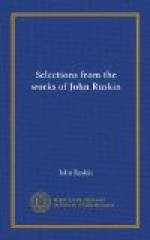And to this end I would ask him now to imagine himself entering, for the first time in his life, the room of the Old Water-Colour Society:[51] and to suppose that he has entered it, not for the sake of a quiet examination of the paintings one by one, but in order to seize such ideas as it may generally suggest respecting the state and meaning of modern, as compared with elder, art. I suppose him, of course, that he may be capable of such a comparison, to be in some degree familiar with the different forms in which art has developed itself within the periods historically known to us; but never, till that moment, to have seen any completely modern work. So prepared, and so unprepared, he would, as his ideas began to arrange themselves, be first struck by the number of paintings representing blue mountains, clear lakes, and ruined castles or cathedrals, and he would say to himself: “There is something strange in the mind of these modern people! Nobody ever cared about blue mountains before, or tried to paint the broken stones of old walls.” And the more he considered the subject, the more he would feel the peculiarity; and, as he thought over the art of Greeks and Romans, he would still repeat, with increasing certainty of conviction: “Mountains! I remember none. The Greeks did not seem, as artists, to know that such things were in the world. They carved, or variously represented, men, and horses, and beasts, and birds, and all kinds of living creatures,—yes, even down to cuttle-fish; and trees, in a sort of way; but not so much as the outline of a mountain; and as for lakes, they merely showed they knew the difference between salt and fresh water by the fish they put into each.” Then he would pass on to mediaeval art; and still he would be obliged to repeat: “Mountains! I remember none. Some careless and jagged arrangements of blue spires or spikes on the horizon, and, here and there, an attempt at representing an overhanging rock with a hole through it; but merely in order to divide the light behind some human figure. Lakes! No, nothing of the kind,—only blue bays of sea put in to fill up the background when the painter could not think of anything else. Broken-down buildings! No; for the most part very complete and well-appointed buildings, if any; and never buildings at all, but to give place or explanation to some circumstance of human conduct.” And then he would look up again to the modern pictures, observing, with an increasing astonishment, that here the human interest had, in many cases, altogether disappeared. That mountains, instead of being used only as a blue ground for the relief of the heads of saints, were themselves the exclusive subjects of reverent contemplation; that their ravines, and peaks, and forests, were all painted with an appearance of as much enthusiasm as had formerly been devoted to the dimple of beauty, or the frowns of asceticism; and that all the living interest which was still supposed necessary to the scene, might be supplied by a traveller in a slouched hat, a beggar in a scarlet cloak, or, in default of these, even by a heron or a wild duck.




